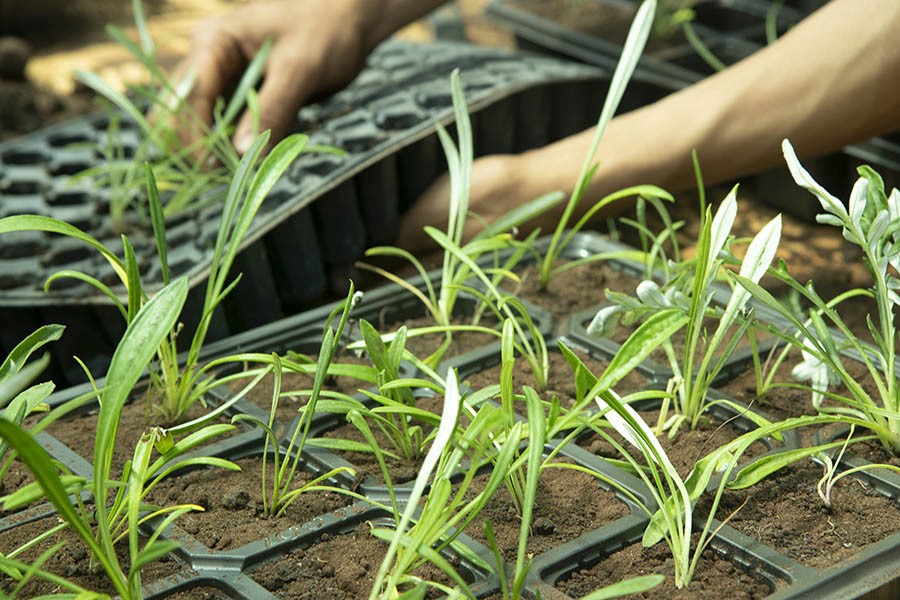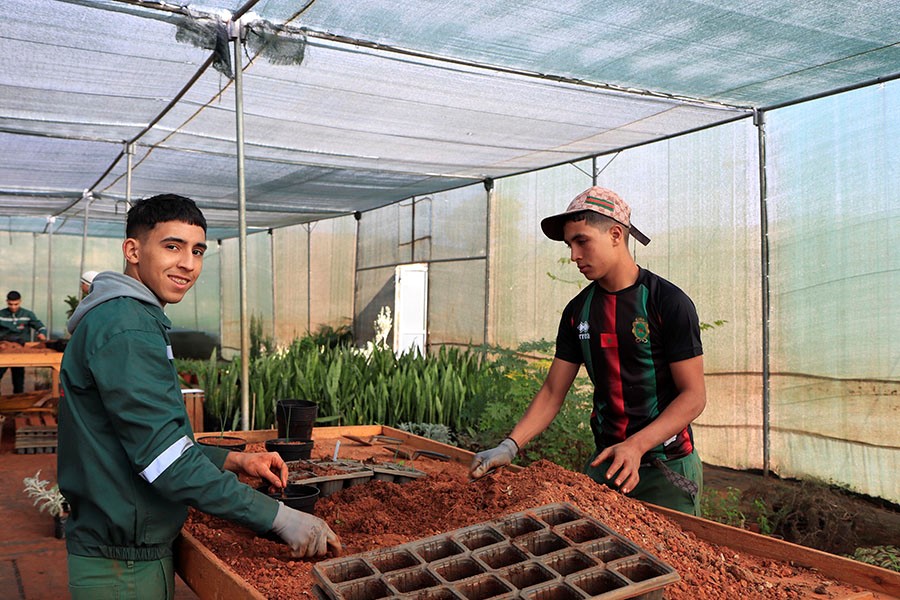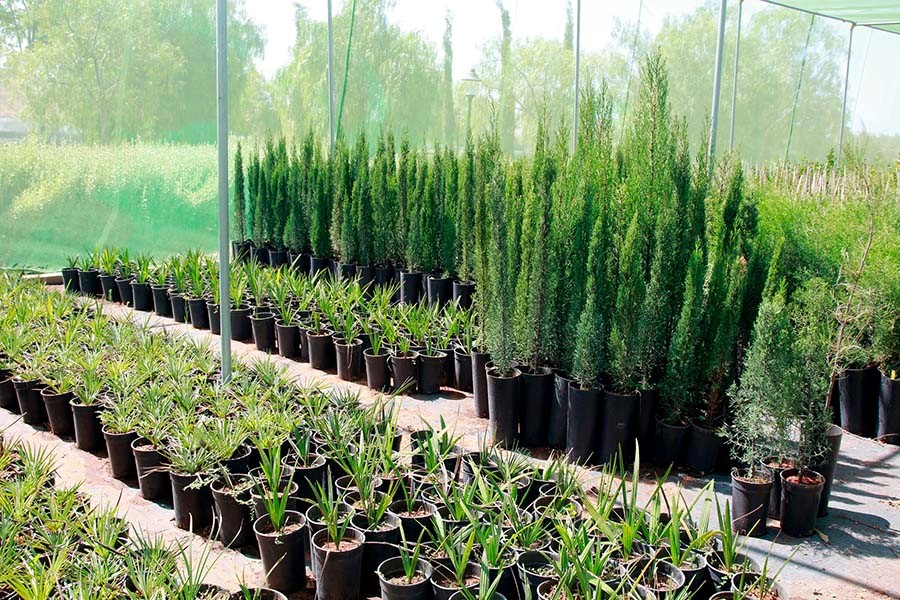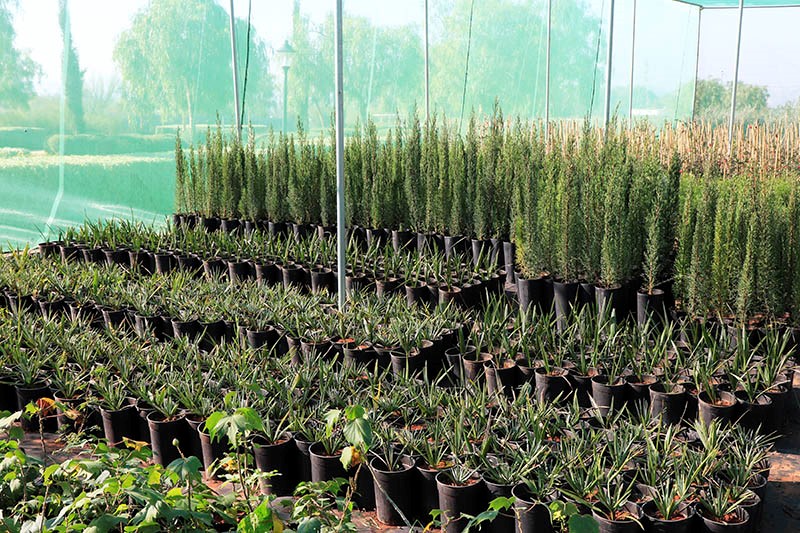The nursery and production centre at the Gardening School is one of the main resources of this project, which provides vocational training in organic gardening with a social focus.
It is part of the subjects taught to all students from their first year of school. It is, therefore, a nursery for educational purposes, where young people learn to grow plants from bulbs and seeds, and to propagate different species through cuttings, divisions, layering and grafting. Sowing, transplanting and planting are part of this speciality, which offers numerous opportunities in the ecological job market.
But beyond this educational aspect, which is the main one, the nursery also sells plants to the public, as one of the activities that generates income for training young people and running the project.
The species produced and propagated at the school come from the park itself, which has around 100 different ornamental species, in order to ensure replacement in the event of the loss of some plants. However, the nursery also aims to produce or “fatten up” species of high ornamental value that are in high demand on the market, particularly flowering plants and, more specifically, species native to Morocco, which are better adapted to climate change and water stress.
However, beyond this educational aspect, which is the main focus, the nursery also sells plants to the public as one of the activities that generates income for training young people and running the project.
Horticulture for cut flowers for florists, a speciality that the School offers to some third-year students through the company Végétal Concept, will also be developed given its economic and educational interest.
Native and endemic species
Morocco is a country blessed with unique biodiversity and great ecological wealth. However, despite its wide variety of endemic and native species, until now there has been no nursery specialising in the production and conservation of these plants in the country. That is why we believe that the production of native plants is the solution to contribute to the preservation of natural heritage, encourage the sustainable use of resources and promote gardening adapted to the climatic conditions of the territory.
One of the main problems encountered at the start of this project was the lack of seed banks for native flora in Morocco. This forced us to conduct our own field surveys to collect seeds directly from their natural environment. This process, in addition to providing us with the necessary material for plant production in our nursery, has allowed us to develop collection programmes that may be useful in the future for other initiatives wishing to undertake projects for the conservation and protection of the country’s flora. Thus, our work not only has an impact on direct plant production, but also lays the foundations for a long-term conservation strategy.
Morocco is a country blessed with unique biodiversity and great ecological wealth.
In addition, the nursery also collaborates with academic and scientific institutions to conduct studies on the reproduction and cultivation of endangered species. In this way, we contribute not only to the preservation of biodiversity, but also to the development of innovative strategies for ecological restoration in the country.
The protection of cultural heritage
The use of native plants is not only an ecological issue, but also a cultural one. Vegetation is an integral part of Morocco’s landscape identity and is deeply linked to its history and traditions.
Trees such as the argan (Argania spinosa), the Barbary thuja (Tetraclinis articulata) and Moroccan lavender (Lavandula maroccana) have been used for centuries in traditional medicine, construction and gastronomy.
However, with the globalisation of landscaping and gardening, many exotic species have replaced native flora in public and private spaces. This leads to a loss of cultural identity and also causes ecological problems, as these species often require intensive maintenance and can affect local flora and fauna. Our nursery seeks to reverse this trend by promoting the use of traditional species in gardens, parks and landscape restoration projects.
Furthermore, by working with native plants, we promote the use of agricultural and landscaping practices inherited from Moroccan tradition. The use of traditional methods combined with modern cultivation and conservation techniques ensures a balanced and sustainable approach to the development of green spaces in the country.
Sustainability and efficiency
Another fundamental reason for producing native plants is the need to promote a more sustainable use of water and energy resources.
Trees such as the argan (Argania spinosa), the Barbary thuja (Tetraclinis articulata) and Moroccan lavender (Lavandula maroccana) have been used for centuries in traditional medicine, construction and gastronomy.
Morocco faces significant challenges in terms of water availability, particularly in the context of climate change. We often use exotic plants in gardening that require large amounts of water and care, which leads to high resource consumption.
On the contrary, native plants, which are better adapted to the country’s climatic conditions, require less water and care. Their use helps to reduce water consumption, decrease the need for fertilisers and pesticides, and promote more environmentally friendly practices. In addition to the benefits for the environment, this also represents significant savings for public and private institutions seeking to develop sustainable projects.
Native plants, which are better adapted to the country’s climatic conditions, require less water and care.
In addition, the school and nursery promote reforestation with native species as a strategy to combat the effects of climate change. Planting native trees and shrubs contributes to carbon sequestration, the restoration of degraded soils, and the creation of habitats for local wildlife.
For a commitment to the future
For us at the school, this nursery represents a commitment to preserving the environment and promoting a model of sustainable development. We believe it is possible to integrate local biodiversity into horticulture and landscaping projects without compromising the aesthetics or functionality of green spaces.
With this nursery, we are working to protect Morocco’s natural and cultural heritage, as biodiversity is a treasure that we must preserve for future generations.
Inés Eléxpuru / Pablo G. Watson
Cet article est disponible en français.
This post is available in: English Español




